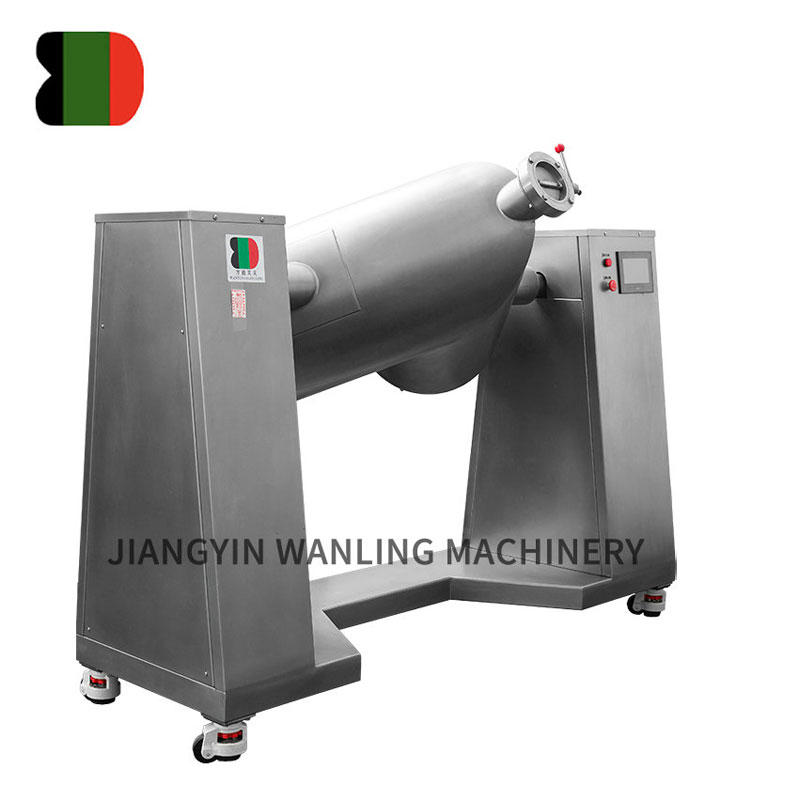To ensure that a V Mixer is performing effectively and producing homogeneous blends, various testing methods can be employed. These methods assess how evenly the materials are distributed throughout the mixture and help identify potential issues with the mixing process. Below are some common and effective testing methods to measure the homogeneity of the mix in a V Mixer:
Sampling and Visual Inspection
Method: Randomly collect samples from different points in the V Mixer (e.g., top, middle, and bottom) during or after the mixing process and visually inspect the uniformity.
What it Measures: The appearance of the mixture, such as whether the colors and particle distributions are uniform.
Pros: Simple and cost-effective.
Cons: Limited in terms of quantitative analysis and may not be sufficient for highly critical applications.
Colorimetric Analysis
Method: Use color sensors or visual inspection to compare the color of samples from various parts of the mixture. This is especially useful for blending colored powders.
What it Measures: Uniformity of color distribution.
Pros: Useful for materials that change color when mixed, like pigments.
Cons: May not work well for materials that don’t have distinguishable colors.
Blend Homogeneity Index (BHI)
Method: Take multiple samples from various points of the mixture and measure the concentration of specific components (using chemical analysis or other techniques) to calculate a Blend Homogeneity Index. This provides a numerical representation of the uniformity.
What it Measures: The uniformity of each ingredient or component within the mixture.
Pros: Provides a clear quantitative measurement of homogeneity.
Cons: Requires sophisticated equipment and is more time-consuming.
Particle Size Distribution Analysis
Method: Use a laser diffraction or sieve analysis to measure the particle size distribution before and after mixing. If the size distribution is uniform, it suggests a homogeneous mixture.
What it Measures: The consistency of particle sizes throughout the mixture.
Pros: Ideal for powders and granular materials.
Cons: May not identify segregation between components with the same particle size but different densities.
X-Ray Fluorescence (XRF) or Near-Infrared (NIR) Spectroscopy
Method: These techniques use sensors to scan the mixture and measure the distribution of elements or compounds. NIR is often used for pharmaceutical products, while XRF can be used for mineral or metal-based mixtures.
What it Measures: The distribution of specific elements or compounds in the mixture.
Pros: Non-destructive and provides fast results.
Cons: Expensive and may not be suitable for all material types.

Microencapsulation and Chemical Tracer Method
Method: Introduce a chemically distinct or microencapsulated tracer into the mix and then measure its concentration in samples taken from different parts of the batch. The degree of uniformity of the tracer distribution is an indicator of blend homogeneity.
What it Measures: The distribution and consistency of a specific component within the mixture.
Pros: Highly effective for very small quantities or specific components.
Cons: Requires precise control and handling of the tracer.
Density Gradient or Separation Method
Method: If the materials being mixed have different densities, after mixing, you can use techniques like density-gradient centrifugation to observe the distribution of components within the mix.
What it Measures: The degree of separation between different components based on their densities.
Pros: Works well for mixtures with very different densities.
Cons: Not applicable to homogeneous materials in terms of density.
Electrical Conductivity Measurement
Method: For conductive materials, you can use electrical conductivity or resistivity testing by measuring the current passing through the mixture at various points. Variations in conductivity suggest non-uniform blending.
What it Measures: Homogeneity of conductive materials.
Pros: Quick and non-destructive.
Cons: Limited to materials that are conductive.
Turbidity Measurement
Method: In some cases, turbidity measurements (cloudiness of a liquid) can be used to assess homogeneity, particularly in liquid mixtures or suspensions.
What it Measures: The distribution of particles within a liquid.
Pros: Simple and fast.
Cons: Limited to liquid-based mixtures, not suitable for powders or granules.
Sieve Analysis for Powder Mixes
Method: If you're mixing powders of different sizes, a sieve analysis can be performed to measure the consistency of the particle size distribution after mixing.
What it Measures: Consistency in the blend of different particle sizes.
Pros: Ideal for powder-based products.
Cons: Doesn’t give a clear picture of homogeneity for non-powder mixtures.
Cohesion or Flowability Tests (e.g., Angle of Repose, Bulk Density)
Method: These tests measure how well the materials in the mixture flow together, which can indicate how homogeneous the blend is. Flowability tests can include the angle of repose or measuring bulk density.
What it Measures: The cohesiveness and flowability of the mixture, which is influenced by homogeneity.
Pros: Simple and inexpensive.
Cons: May not fully capture particle distribution issues.
Microscopy or Scanning Electron Microscopy (SEM)
Method: Use microscopy techniques to inspect a small cross-section of the mixture, identifying how evenly the particles or components are dispersed.
What it Measures: The microscopic uniformity of the blend.
Pros: Highly detailed analysis.
Cons: Labor-intensive and requires specialized equipment.



 Español
Español














